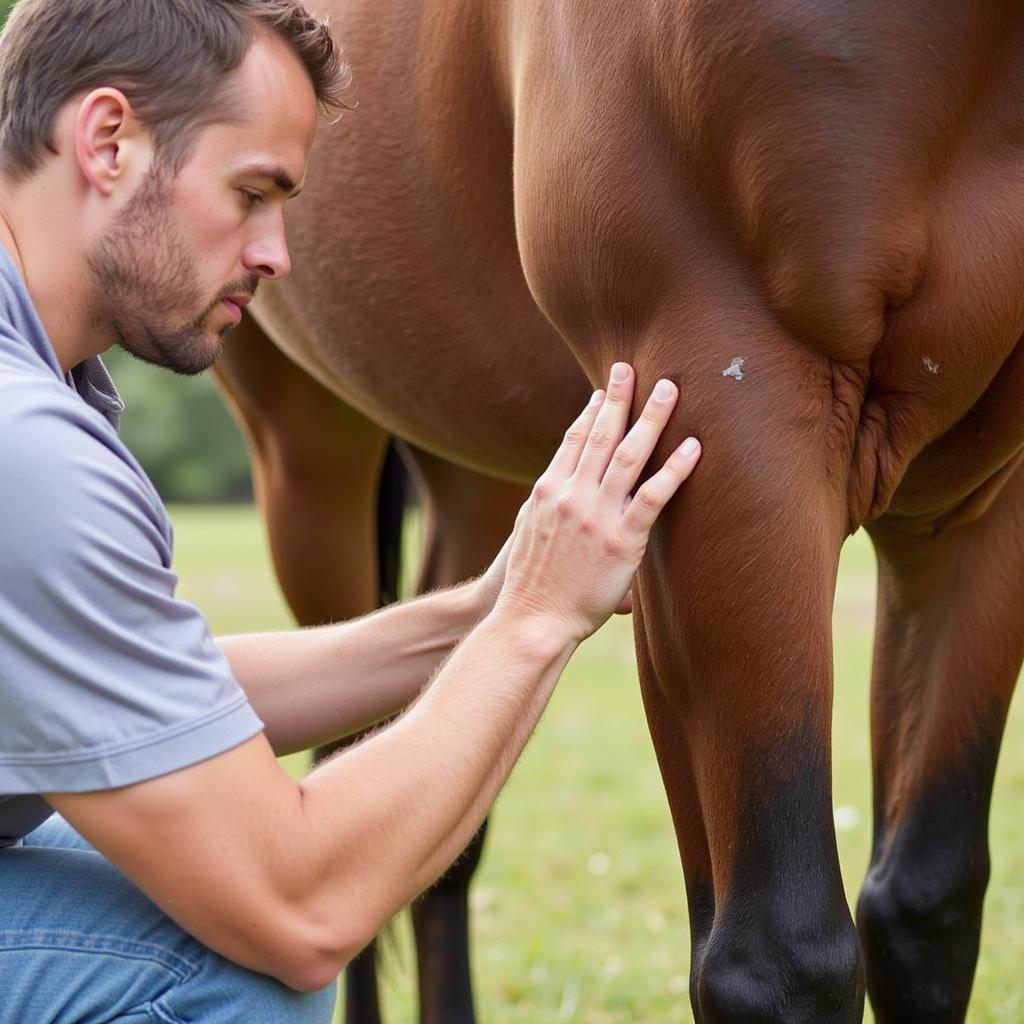Corona Horse Liniment is a staple in many horse owners’ tack boxes. It’s a versatile topical solution used to soothe and relieve minor aches and pains in horses. But what exactly is it, how does it work, and when should you use it? This guide will delve into everything you need to know about corona horse liniment, from its ingredients and uses to potential side effects and precautions.
Understanding Corona Horse Liniment
Corona horse liniment is a topical solution, meaning it’s applied directly to the skin. It’s primarily used for temporary relief of minor muscle soreness, stiffness, and inflammation in horses. The liniment works by creating a warming sensation that helps to increase blood flow to the affected area. This increased circulation can help to reduce pain and promote healing.
Ingredients and How They Work
The active ingredients in corona horse liniment vary depending on the specific formulation, but typically include ingredients like menthol, camphor, and oils such as turpentine or mineral oil. Menthol and camphor create the cooling and then warming sensation, acting as counterirritants. They essentially distract the nerves from the underlying pain. The oils act as carriers, facilitating the absorption of the active ingredients into the skin.
When to Use Corona Horse Liniment
Corona horse liniment can be helpful in a variety of situations, including:
- Muscle soreness after exercise: After a strenuous workout, corona liniment can help to ease muscle stiffness and soreness.
- Minor sprains and strains: For minor soft tissue injuries, the liniment can help to reduce inflammation and promote healing.
- Arthritis pain relief: While it won’t cure arthritis, corona liniment can provide temporary relief from pain and stiffness associated with the condition.
- Pre-workout warm-up: Some horse owners use the liniment as part of their warm-up routine to help increase blood flow and flexibility.
 Applying Corona Liniment to a Horse's Leg
Applying Corona Liniment to a Horse's Leg
Precautions and Potential Side Effects
While corona horse liniment is generally safe when used as directed, it’s essential to follow the manufacturer’s instructions carefully.
- Avoid contact with eyes and mucous membranes: The liniment can cause irritation if it comes into contact with sensitive areas.
- Do not apply to open wounds or broken skin: Applying the liniment to damaged skin can cause further irritation and delay healing.
- Use sparingly: A little goes a long way. Overuse can lead to skin irritation and other problems.
- Monitor for allergic reactions: While rare, some horses may be allergic to certain ingredients in the liniment. Watch for signs of skin irritation, such as redness, swelling, or itching.
“Always perform a patch test on a small area of skin before applying the liniment to a larger area,” advises Dr. Sarah Miller, DVM, an equine veterinarian with over 20 years of experience. “This can help you identify any potential allergic reactions before they become a bigger problem.”
Choosing the Right Corona Horse Liniment
Several different formulations of corona horse liniment are available, each designed for specific needs. Some are formulated for everyday use, while others are more concentrated for more intense relief.
Understanding the Different Formulations
- Original Formula: This classic formula typically contains menthol, camphor, and essential oils.
- Extra Strength: This formulation contains a higher concentration of active ingredients for more potent relief.
- Cooling Formula: These formulations often include additional ingredients like aloe vera or witch hazel to provide a cooling and soothing sensation.
Corona Horse Liniment: Your Partner in Equine Care
Corona horse liniment can be a valuable tool for managing minor aches and pains in your horse. By understanding how it works, when to use it, and the necessary precautions, you can help keep your equine companion comfortable and performing at their best. Remember to always consult with your veterinarian if you have any concerns about your horse’s health.
“Corona liniment isn’t a substitute for proper veterinary care,” reminds Dr. Miller. “It’s a useful tool for managing minor discomfort, but if your horse is experiencing persistent pain or lameness, it’s crucial to seek professional advice.”
FAQ
- Can I use corona horse liniment on other animals?
- It’s best to use products specifically formulated for other animals.
- How often can I apply corona horse liniment?
- Follow the manufacturer’s instructions. Typically, application is limited to a few times a day.
- What should I do if my horse experiences an allergic reaction?
- Discontinue use immediately and consult your veterinarian.
- Can I use corona horse liniment on open wounds?
- No, avoid applying the liniment to open wounds or broken skin.
- Is corona horse liniment a cure for arthritis?
- No, it provides temporary pain relief but does not cure the underlying condition.
- Can I use human liniment on my horse?
- No. Always use products specifically formulated for horses.
- Where can I buy corona horse liniment?
- It’s available at most tack shops and online retailers.
Common Scenarios and Questions
- My horse is stiff after a long trail ride. Can I use Corona liniment? Yes, applying Corona liniment can help soothe muscle soreness after exercise.
- My horse has a small cut on its leg. Can I apply Corona liniment around the wound? No, avoid applying liniment near open wounds.
- My horse seems to be in constant pain. Should I use Corona liniment daily? Persistent pain requires veterinary attention. Consult your vet before using liniment long-term.
Further Reading
For more information on equine health and wellness, visit our other articles on [link to another article on your website]. Learn more about caring for your horse’s legs with our guide on [link to another relevant article on your website].
Contact us for support: Phone: 0772127271, Email: [email protected] Or visit our address: QGM2+WX2, Vị Trung, Vị Thuỷ, Hậu Giang, Việt Nam. We have a 24/7 customer support team.